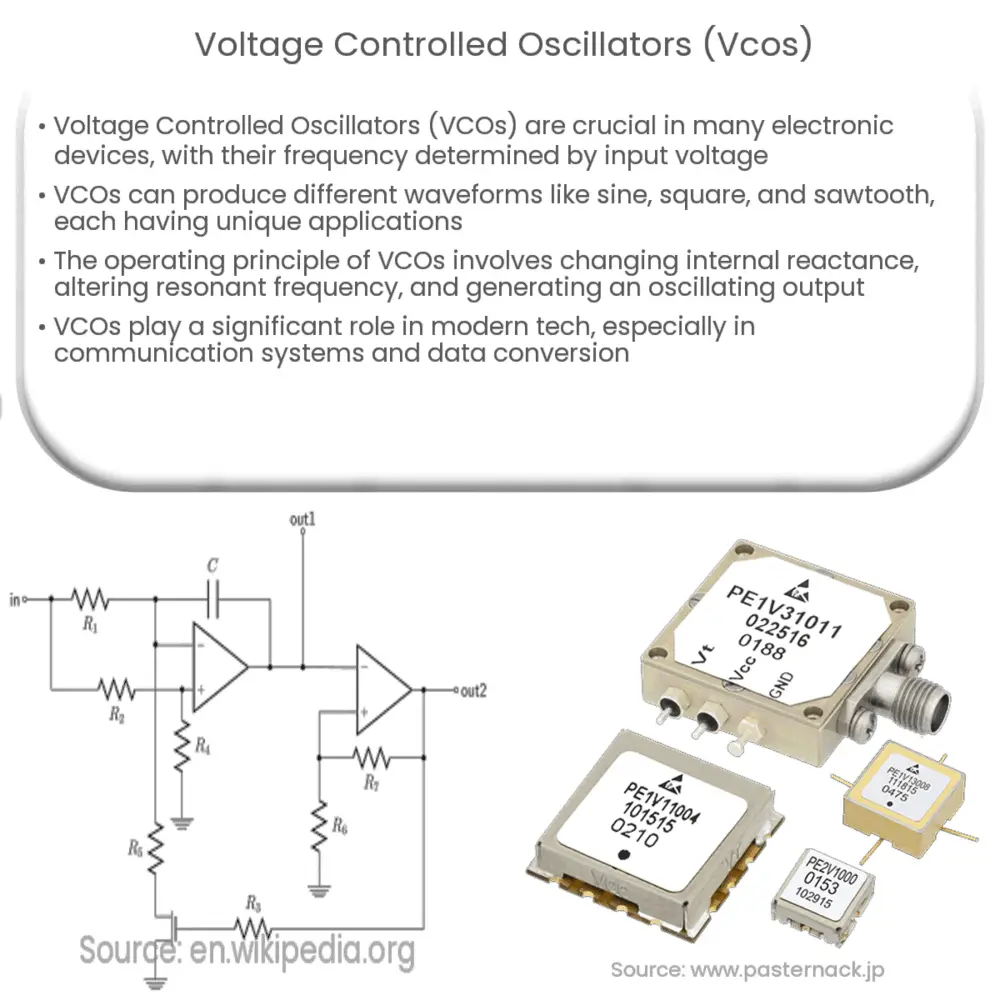Explore the fundamentals of Voltage Controlled Oscillators (VCOs), their types, operating principles, applications, and future directions.

Voltage Controlled Oscillators (VCOs): An In-Depth Look
Voltage Controlled Oscillators, widely known as VCOs, are an integral part of various electronic devices we use daily. Their versatility is evident as they are essential components in radio frequency synthesizers, function generators, and phase-locked loops (PLLs), just to mention a few.
Understanding VCOs
A Voltage Controlled Oscillator is an oscillator whose frequency of operation is determined by the input voltage. This unique capability is a key characteristic that defines their function in numerous electronic devices. A change in input voltage causes a corresponding change in oscillation frequency, making VCOs fundamentally frequency modulators.
Types of VCOs
Sine Wave Oscillators: This type generates a sinusoidal output waveform. It is used in applications where a clean, harmonic-free signal is required. Its main disadvantage is a limited frequency range.Square Wave Oscillators: These produce a square wave output signal. Their main advantage is their ability to operate over a wide frequency range, but they often contain harmonic distortion.Sawtooth Wave Oscillators: Known for generating a sawtooth waveform, these are typically used in the timebase circuits of oscilloscopes and television systems where a linear sweep is necessary.
Operating Principle of VCOs
The operating principle of a VCO can be broadly divided into three steps. Firstly, a DC control voltage is applied. This voltage changes the internal reactance of the VCO – which could be the capacitance in a varactor diode or the inductance in a varactor-tuned inductor. Secondly, this change in reactance alters the resonant frequency of the VCO’s internal LC (inductor-capacitor) or RC (resistor-capacitor) circuit. Finally, the VCO generates an oscillating output signal at this new frequency. The frequency of the output signal directly corresponds to the magnitude of the applied control voltage.
Applications of VCOs
- VCOs are commonly used in synthesizers to generate different musical notes. By varying the control voltage, the oscillator produces sounds of varying pitch.
- They are essential in radio frequency synthesizers and are used in the modulation and demodulation processes in both analog and digital communication systems.
- VCOs are fundamental to Phase-Locked Loop (PLL) circuits, a system that synchronizes an oscillator’s phase to the phase of an input signal, widely used in radio, computer, and telecommunications systems.
Design Considerations for VCOs
Designing a VCO requires careful consideration of various parameters. The first of these is frequency range, which refers to the span of frequencies that the VCO can generate. This is typically determined by the control voltage. Frequency stability is another crucial factor, as the generated frequency should remain stable against fluctuations in environmental factors like temperature and power supply voltage. Furthermore, the linearity of the frequency versus control voltage is an essential characteristic that ensures the predictability and repeatability of the VCO’s operation.
VCOs in Modern Technology
In today’s digital age, VCOs have found a significant role in state-of-the-art technology. They are a key component in Frequency Division Multiple Access (FDMA) systems used in satellite and mobile communication. In digital systems, VCOs are often integrated into Phase-Locked Loop (PLL) circuits for clock generation and recovery. Moreover, VCOs are now widely used in data conversion systems like Analog-to-Digital Converters (ADCs) and Digital-to-Analog Converters (DACs).
Challenges and Future Directions
While VCOs have myriad applications, they are not without challenges. Designing a VCO that operates with a wide frequency range while maintaining excellent phase noise performance is a considerable task. Moreover, achieving high frequency stability can be difficult. As we move towards an increasingly digital world, these challenges are being addressed through novel techniques and innovative design methodologies.
Conclusion
In conclusion, Voltage Controlled Oscillators, or VCOs, are an integral part of many electronic devices and systems, from radio frequency synthesizers to modern digital communication systems. Their ability to change their frequency of operation in response to a control voltage makes them versatile and essential in various applications. As we continue to push the boundaries of electronic and communication technologies, the significance of VCOs only promises to increase. This highlights the need for continued research and development to overcome design challenges and improve their capabilities, paving the way for more innovative applications in the future.

